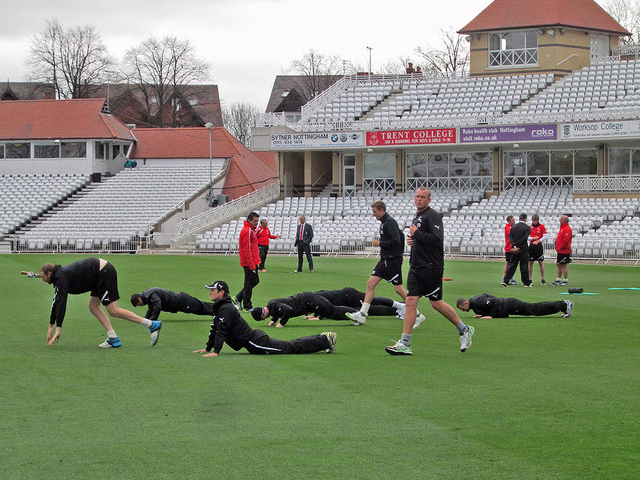|
 Fear. Fear.
It’s a natural reaction to the unknown and a way of protecting yourself. But your job isn’t to live in fear of negative results, it’s to improve.
And that means learning some of the basics of general fitness alongside cricket skills.
We know fast, mobile, coordinated and athletic people are the best cricketers. These are traits that can be taught just like cricket skills.
If you can get over that fear.
Play to get fit?
Some say that fitness comes from playing the game. There is no need to do anything else because the more you play the more match fit you get.
Why bother with anything else?
Yes, match fitness is a crucial part of the fitness jigsaw. No amount of strength training is going to teach your body how to bowl 25 overs in a day. But to say you play to get fit has it the wrong way around.
You get fit to play.
Doing it that way around means that players - even from the age of five - are learning universal skills.
Good cricket training teaches "fitness" skills like running, changing direction, throwing, jumping, catching, and coordination. As players get older it builds up injury-resistant bodies.
If it wasn’t for that fear, why wouldn’t you be trying to be like this?
Here are the basics.
First, have some fun
Strength and conditioning is not often associated with fun. It should be though, because at any age there is a desire to enjoy what you are doing. Whether you are a five year old beginner or a 40 year old trying to prolong your career, fun is a key element.
An effective method is to focus on a specific "physical literacy" skill every cricket training session. You can be creative with it but here are some ideas:
- Speed: Use simple running races, making sure you keep it close by competing with someone close to your pace. Between races discuss how you can run faster. You don’t need to know much about sprinting technique, jut be prepared to test things out.
- Agility: Use races with a change of direction in them. This can include starting from different positions (sitting, backwards, lying, walking) and different types of change (cut left or right, 180 degree turn, sudden stop and go). To make it less formal you can play team games with a ball and a scoring system. Starting, stopping and changing direction will all improve naturally.
- Jumping: Simple competitions can be used here to see how far you can jump on two or one leg. Lay out flat markers gradually increasing in distance apart and see how far down the line players can get. Jumping is really all about knowing how to land so cue by encouraging a soft landing.
Sneak in the fitness stuff as a warm up and move on to more cricket specific skills. There's a big crossover anyway so you should find it easy.
Get the basics right
The next stage is less outright fun and more focused on getting the basics right. You can still use the warm up for these drills but the are now more conspicuously fitness work and so work better with older players.
- Mobility: Start each session with drills to improve dynamic mobility. Focus on the ankle, hip, thoracic spine and shoulder.
- Strength: Take time to learn the proper technique in common bodyweight and resistance exercises. The idea is understanding how to do basic movement patterns: the squat (one and two leg), the deadlift, the row, the pull up and the push up as well as core exercises and stability work. A resistance band is the easiest way to add resistance. Insist on strict technique and go for quality not quantity.
- Conditioning: for most, this is what fitness means; getting a sweat on. To make it specific, and sneak in improvements while no one notices, make fielding drills longer to get used to interval style training.
Once you are done with the warm up (and 15-20 minutes should be plenty) you can get on with the cricket practice.
If you are feeling very clever you can even slip in some more work as you go along. For example, getting the batsmen waiting to go in the net to do some mobility drills or strength training.
Want more serious training?
So far we have looked at sneaking some fitness in here and there. It will help but to go up a level you need a little more. The problem is that both knowledge and equipment is hard to come by.
One thing you can feel happy doing is getting out of breath. Endurance levels soar with some serious interval training.
You could set aside an extra training session to do this but many at school or club level with a limited time will want bang for the buck and combine it with other drills.
Fielding drills and fitness make a lot of sense. Most out-fielding drills can be adjusted to make the distance covered longer. Keep groups small and waiting times short. Work time (that's when they are doing the drill) should be on a 1:2, 1:1 or 2:1 basis depending on fitness levels. So a 1:1 ratio is 30 seconds work, 30 seconds rest. 1:2 is 30 seconds work with 60 seconds rest.
Running between the wickets can be added to net training or middle practice easily. You can even have specific sessions that focus on running between the wickets that will do the fitness job too. Again, keep your mind on work to rest periods.
Strength work is more difficult, as to move beyond basic bodyweight and band work, you need weights, probably in a gym. Seek out a good trainer to help you with this. It might be costly but if you are serious, strength is proven to boost your game.
At this point, recovery becomes a crucial aspect. Sore and tired players won’t do well. You can help players learn how to recover better through advising on:
None of this is complicated, but it is often ignored or seen as a waste of time. However, if you get the simple things right here, you can see huge gains.
Discuss this article with other subscribers
|

.jpg)



.jpg)

